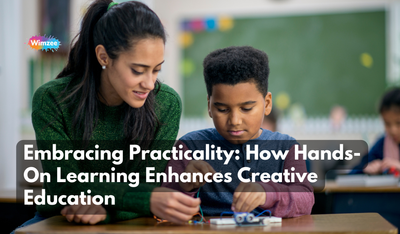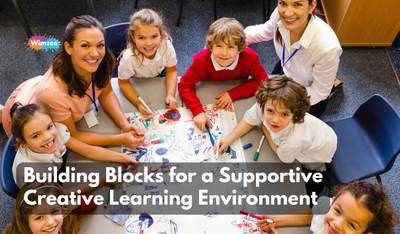Why should the classroom be confined to just books and lectures? Imagine a learning environment where every task and project brings theories to life, making education not only more engaging but deeply intuitive. That’s the power of hands-on learning, a dynamic approach that transforms the abstract into tangible experiences, enhancing how students of all ages—from playful preschoolers to innovative adults—absorb and apply knowledge.
Understanding Hands-On Learning
What is Hands-On Learning?
Hands-on learning, also known as experiential learning, is an educational approach where students engage directly with the materials and processes they're learning about, rather than absorbing knowledge passively through lectures or readings. This method emphasizes active participation and real-world application of skills and knowledge. In essence, hands-on learning means students learn by doing, which can include activities such as experiments, building projects, or simulating real-life situations.
Core Characteristics of Hands-On Learning
The core of hands-on learning is its emphasis on direct experience and focused reflection. It supports various learning styles including visual, auditory, and kinesthetic, catering to a diverse range of learners by allowing them to interact with the material in multiple ways. Visual learners benefit from seeing processes in action, auditory learners gain from discussing and explaining their actions, and kinesthetic learners thrive by physically engaging with tasks (LMS Hero).
Psychological Basis and Cognitive Benefits
The psychological foundation of hands-on learning lies in its ability to make educational experiences more engaging and memorable, thereby improving knowledge retention. Engaging directly with tasks allows learners to form deeper connections with the material, enhancing their understanding and ability to apply knowledge in different contexts. This active involvement boosts critical thinking and problem-solving skills, as learners are often required to analyze situations and devise solutions on the spot (Skillable).
Students who engage in hands-on learning are also more likely to develop important social skills through group activities and projects, which require communication, collaboration, and conflict resolution. Moreover, this approach can significantly increase student motivation and confidence, as they see the tangible results of their efforts and understand how their learning applies in the real world (Lectera).
In conclusion, hands-on learning transforms theoretical knowledge into an interactive and impactful experience. It encourages students to actively participate in their own learning journey, making education a dynamic and integrative process that prepares them not just academically, but also personally and professionally.
The Synergy Between Theoretical and Practical Learning
Balancing Knowledge and Application
The interplay between theoretical and practical learning forms the cornerstone of a comprehensive education system. Theoretical learning provides the groundwork, helping students understand fundamental concepts and theories. This method involves learning through books, lectures, and other resources where the focus is on absorbing knowledge. On the other hand, practical learning, or hands-on education, enables students to apply this theoretical knowledge in real-world situations through experiments, projects, and other interactive activities.
Deepening Understanding
Practical applications of theoretical knowledge not only make learning more engaging but also deepen the students' understanding. By applying concepts learned in theory to real-life challenges, students can see the relevance of their studies and are better able to retain information. This method fosters a deeper connection with the material, making abstract concepts more tangible and understandable. For instance, in science classes, understanding the theory behind chemical reactions becomes more impactful when students can conduct experiments and see the reactions unfold.
Fostering Critical Thinking
A balance of theoretical knowledge and practical application is essential for developing critical thinking skills. Theoretical learning encourages students to think deeply about concepts, analyze information, and evaluate different perspectives. When paired with practical learning, it allows them to test these theories and ideas in real-world scenarios, enhancing their problem-solving abilities and enabling them to adapt their knowledge to various contexts (Curious Mind Magazine).
Bridging the Gap for Better Outcomes
Integrating practical learning with theoretical education addresses the needs of today's dynamic job market by preparing students not just academically but also equipping them with essential skills. Programs like the School-Work Alternation (SWA) in Italy exemplify how educational systems are evolving to bridge the gap between classroom learning and professional requirements. Such programs offer students firsthand exposure to work environments, thereby enhancing their employability and readiness for professional life.
The synergy between theoretical and practical learning enriches the educational experience, making it more relevant, engaging, and effective. By fostering an environment where students can explore and apply their knowledge, educators can cultivate a generation of learners who are not only knowledgeable but also skilled and adaptable. This balanced approach prepares students for both academic success and practical, real-world application, creating a well-rounded educational journey that supports lifelong learning and adaptability (MDPI).
Hands-On Learning in Creative Disciplines
Enhancing Skills Through Practical Learning
In the realm of creative disciplines like music production, fashion design, and comedy, hands-on learning isn't just beneficial; it's essential. By engaging directly with the tools and techniques of their trade, learners in these fields can acquire and refine skills that are often difficult to develop through theory alone.
Music Production
In music production, the hands-on approach takes several forms. Utilizing a Digital Audio Workstation (DAW) like Ableton Live allows aspiring producers to experiment with sound manipulation, mixing, and editing in real-time. This practical engagement helps solidify understanding of music theory through direct application and leads to a deeper grasp of sound design and audio engineering (Udemy). Programs like these offer comprehensive tools that simulate real-world studio environments, enabling users to practice and master the craft of song creation from initial idea to final mix (MusicTech).
Fashion Design
Similarly, in fashion design, hands-on learning involves everything from sketching initial designs to actually constructing garments. This direct involvement allows designers to understand materials, work with various fabrics, and appreciate the nuances of garment construction and textile manipulation. It's one thing to conceptualize a piece of clothing, but creating a wearable item introduces a myriad of practical challenges and learning opportunities, such as understanding sustainability practices and the lifecycle of clothing materials.
Comedy
For comedians, hands-on learning typically revolves around writing and performing. Workshops and improv classes are common methods where comedians can test their material in a supportive environment, receive feedback, and refine their delivery based on audience reaction. This real-time testing and adaptation are crucial for developing a comedian’s timing and ability to engage with viewers.
Incorporating Engaging Projects
Hands-on projects can significantly enhance the learning experience in these fields. For instance, music production students might undertake projects such as creating an EP using specific software tools, or fashion students might host a sustainable fashion show. These projects not only build practical skills but also encourage creativity and innovation.
The power of hands-on learning in creative disciplines lies in its ability to bridge the gap between theoretical knowledge and real-world application. Whether it’s through crafting a piece of music, designing a new fashion line, or performing a stand-up set, practical experiences allow learners to apply and expand their creative skills in meaningful and impactful ways.
Supporting Hands-On Learning at Home
Creating a conducive environment for hands-on learning at home is not just about having the right tools and materials, but also about fostering a mindset and physical space that encourages exploration and creativity.
Creating the Right Environment
Setting up a designated learning space is crucial. This area should be well-lit, free of clutter, and ideally, separate from play areas to help your child differentiate between playtime and learning time. Keeping this space organized and stocked with materials like paper, markers, building blocks, and other resources that encourage creativity can make a big difference. For younger children, everyday items can become powerful learning tools. For instance, items like cardboard boxes, plastic cups, and old clothes can be used for imaginative play and learning projects.
Incorporating Technology Wisely
While traditional hands-on activities are invaluable, technology also plays a significant role in modern education. Use educational apps and online resources that complement physical activities. For example, apps like Prodigy Math Game offer math practice through fun, interactive challenges that align with curriculum standards. Platforms like Khan Academy and Time4Learning provide structured lessons in various subjects, allowing children to extend their learning beyond the traditional classroom setting (Prodigy Game).
Utilizing Multisensory Approaches
Children learn best when they engage multiple senses. At home, you can incorporate multisensory learning techniques by using tactile materials for lessons, employing audio books for literacy, and even having children act out stories or historical events. This approach not only makes learning more engaging but also enhances retention and understanding (Reading Rockets).
Parental Involvement and Support
Your involvement is key. Regularly engage with your child about what they are learning. This could be as simple as discussing a book, conducting a science experiment together, or even cooking a meal where you explain the science behind cooking processes. Recognize their efforts and celebrate progress to keep them motivated.
Adapting to Each Child’s Needs
Every child is unique, and what works for one might not work for another. Be flexible in your approaches and willing to adjust your strategies based on your child’s responses. Some might need more structured activities, while others thrive on exploratory, self-directed projects.
Creating a supportive environment for hands-on learning at home involves a combination of proper space, resources, technology, and, most importantly, a supportive and adaptive approach by parents. By integrating these elements, you can significantly enhance your child's learning experience and make it both fun and effective.




